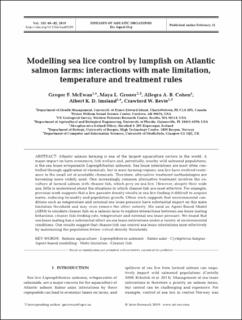| dc.description.abstract | Atlantic salmon farming is one of the largest aquaculture sectors in the world. A major impact on farm economics, fish welfare and, potentially, nearby wild salmonid populations, is the sea louse ectoparasite Lepeophtheirus salmonis. Sea louse infestations are most often controlled through application of chemicals, but in most farming regions, sea lice have evolved resistance to the small set of available chemicals. Therefore, alternative treatment methodologies are becoming more widely used. One increasingly common alternative treatment involves the co-culture of farmed salmon with cleaner fish, which prey on sea lice. However, despite their wide use, little is understood about the situations in which cleaner fish are most effective. For example, previous work suggests that a low parasite density results in sea lice finding it difficult to acquire mates, reducing fecundity and population growth. Other work suggests that environmental conditions such as temperature and external sea louse pressure have substantial impact on this mate limitation threshold and may even remove the effect entirely. We used an Agent-Based Model (ABM) to simulate cleaner fish on a salmon farm to explore interactions between sea louse mating behaviour, cleaner fish feeding rate, temperature and external sea louse pressure. We found that sea louse mating has a substantial effect on sea louse infestations under a variety of environmental conditions. Our results suggest that cleaner fish can control sea louse infestations most effectively by maintaining the population below critical density thresholds. | en_US |
